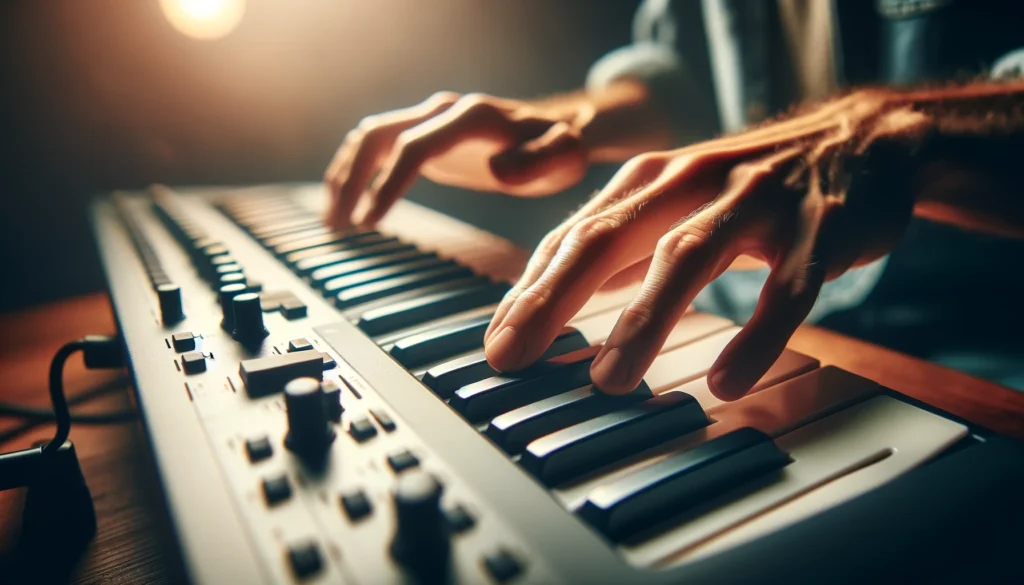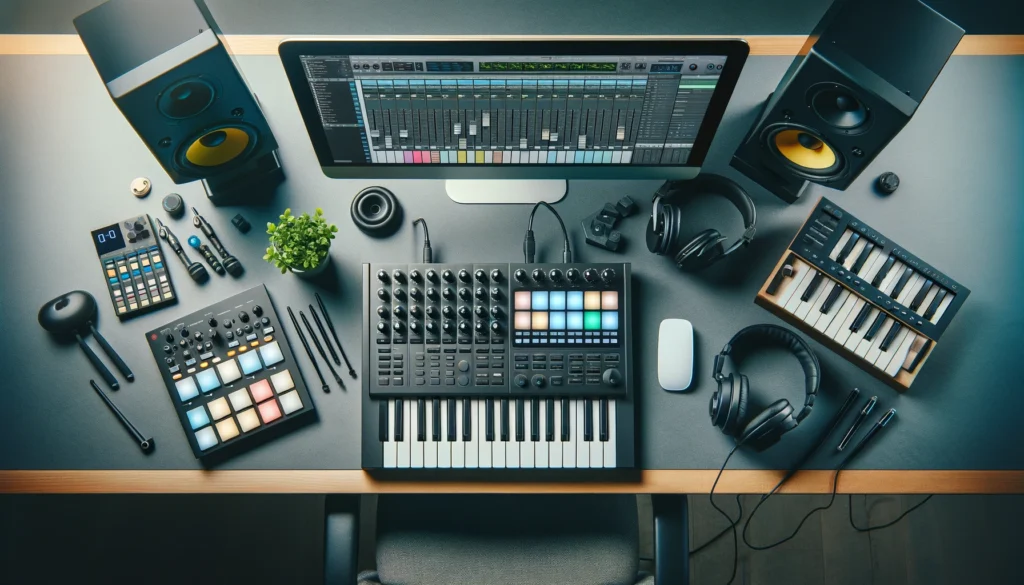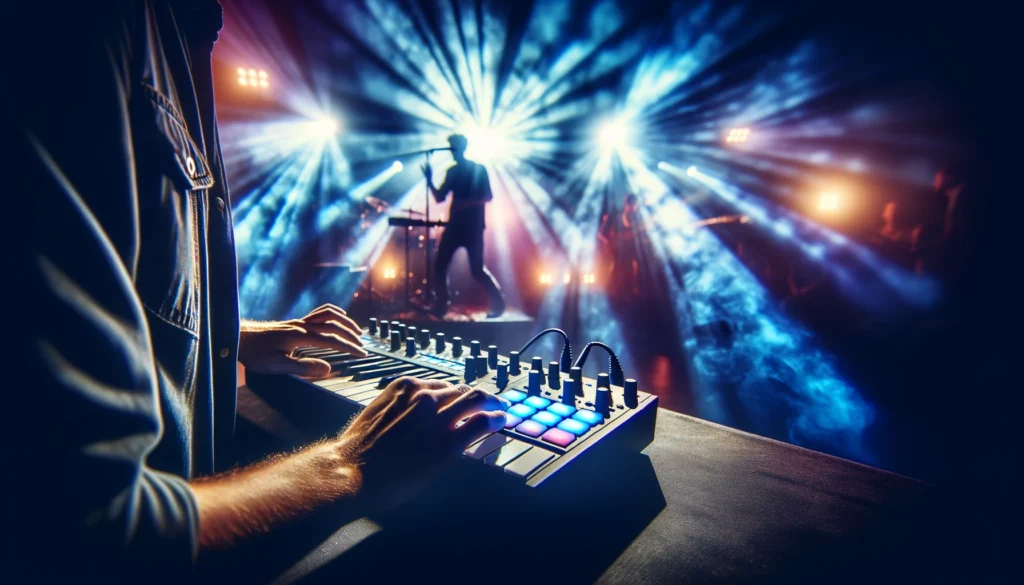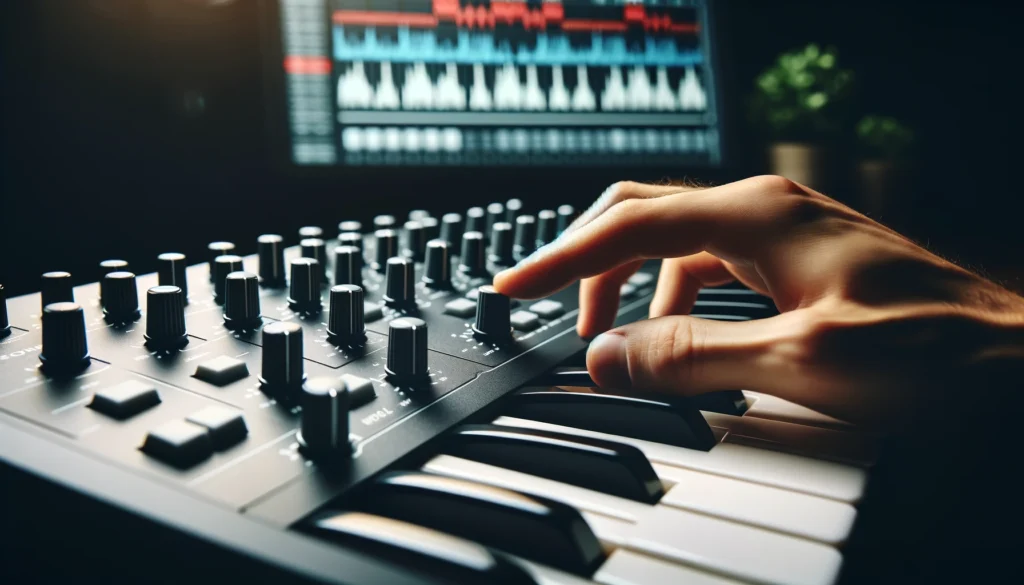Struggling to play expressive parts or control your music software with just a computer keyboard and mouse?
MIDI controller keyboards provide direct hands-on control to enhance performance dynamics and streamline music production workflows.
Let’s explore what exactly these devices are, their key components, creative applications, top benefits for music-makers, product variations, and why MIDI controllers are essential tools for computer-based production.
What is a MIDI Controller Keyboard?

A MIDI controller keyboard is an electronic music device that can control other MIDI-capable devices, software, and hardware.
Unlike a traditional musical keyboard or digital piano, a MIDI controller does not produce its own sounds.
Instead, it transmits MIDI data, which stands for Musical Instrument Digital Interface.
This MIDI data gets sent when keys, pads, knobs, faders, or other controls on the MIDI controller are pressed, struck, or moved.
The MIDI messages contain performance information that can be recorded and edited or used to trigger and manipulate sounds in real time.
Common controls found on MIDI controller keyboards include full-size, synth-action keys, pitch and modulation wheels, octave range buttons, programmable knobs, transport controls, and keypads with drum pads or other triggers.
The keyboards typically connect to a computer or mobile device via USB or a 5-pin MIDI cable.
Software instruments and digital audio workstation programs running on the computer can receive the MIDI data from the controller to generate musical parts, adjust parameters, and more.
Standalone hardware synthesizers and MIDI sound modules can also be played and automated with a MIDI controller keyboard’s output.
Key Components of a MIDI Controller
MIDI controller keyboards contain several key components that facilitate tactile interaction with music software and gear.
These elements expand on musical expression, streamline workflows, and open up creative options beyond what is possible with only a traditional computer keyboard and mouse.
Keyboard for Playing and Inputting Notes
The main keyboard on a MIDI controller resembles that of a synthesizer or digital piano.
It allows for playing notes and chords to trigger software instrument sounds for recording compositions and performances.
The keyboards use velocity-sensitive keybeds, often with aftertouch.
This means pressing the keys harder makes the notes louder.
Aftertouch applies effects like vibrato by continuing to press down on keys after the initial strike.
Compared to piano-style keyboards on digital pianos, MIDI controller keyboards utilize synth action keybeds.
These allow for faster repeating notes when playing rapid musical parts.
The keys have a lighter touch and shallower key dip than tactile piano keys.
Different size MIDI keyboards are available ranging from small 25-key models to full 88-key versions spanning the entire piano range.
Knobs, Faders and Pads for Controlling Parameters
In addition to the musical keyboard, MIDI controllers incorporate various buttons, knobs, sliders (faders), and pads.
These assignable controls enable producers and performers to manipulate software parameters in real time.
For example, the knobs and faders can adjust volume, panning, instrument filters, effect intensities and more.
Keypads with 16 or more velocity and pressure-sensitive drum pads allow for triggering samples and inputting rhythmic patterns.
Buttons provide quick access for changing octaves, transposing notes, selecting programs or instrument patches, and controlling the transport (play, record, etc.) in music production software.
Some controllers feature separate touchstrips and MP3 player-style jog wheels for pitch bending, manipulating effects, and scrolling through tracks.
Combined, these controls enhance real-time playing dynamics and streamline software operation without accessing menus via the computer’s interface.
Pitch and Modulation Wheels
Most MIDI controller keyboards have pitch bend and modulation wheels located to the left of the playing keys.
The pitch wheel handles dramatic or subtle bends in pitch for expressive playing effects.
Guitar string bends and whammy bar effects are possible by pushing the wheel up and down.
The mod wheel adjusts modulation parameters like vibrato depth, filter brightness, tremolo variance and more based on what is assigned within the music software or hardware synth.
These wheels add essential variation to performances beyond volume (velocity) adjustments from the keys alone.
Buttons to Change Octaves, Settings, Presets
A typical MIDI controller has buttons designated for shifting the keyboard playing range up or down by octaves.
This expands the pitch range when playing basslines down low or lead parts way up high.
Buttons labeled program change, patch select or preset allow for switching between instrument, effects and loop types within music software and hardware sound devices.
Most controllers have a data entry section for naming/saving presets and navigating menus.
Other buttons offer variations like transposition to shift pitches up/down for alternative tonalities without learning new fingerings.
Connectivity for Data Transfer
The connective ports on a MIDI controller facilitate transferring the MIDI performance data to software and gear.
Nowadays, almost all MIDI keyboards use USB ports and cables to interface with computers rather than the older 5-pin MIDI ports.
However some controllers provide options for MIDI I/O to connect with standalone synths, drum machines and other hardware.
Potential connectivity options include USB-B, USB-C, USB-A host ports, 5-pin MIDI In/Out, MIDI thru and more.
Wireless Bluetooth MIDI controllers are also available for cable-free operation.
What Can You Do With a MIDI Controller Keyboard?

MIDI controller keyboards have many functions for music production, songwriting, performing, and learning to play instruments.
The tactile controls lend themselves to dynamic sound manipulation and real-time adjustment options that are not possible with the traditional point-and-click computer mouse.
Common MIDI controller applications include:
Playing Software Instruments and Synth Sounds
The main purpose of MIDI controllers is playing instrument sounds contained in music software programs and external sound modules.
The keyboard, pads, and buttons essentially serve as triggers that generate notes and chords to playback desired timbres like piano, organ, strings, drums, guitar, synthesizers, orchestral elements, etc.
The sound options are abundant spanning realistic acoustic renditions to otherworldly electronic tones per the software instruments, virtual synthesizers, and samples contained in the paired music programs or hardware devices.
Adjusting Parameters Like Filters, Effects in Real Time
In addition to playing pitched notes, the physical controllers allow for manipulating parameters that shape and alter the sound during performance.
For example, turn the filter knob on the MIDI keyboard to make a synthesizer tone go from mellow to bright.
Push the mod wheel up to add vibrato depth to a string section.
Fade a rotating panning knob to gradually shift electric piano notes from the left to right speaker as you hold down chord sustains.
These tweaks happen in real time for far greater expression compared to drawing in data with a mouse.
Inputting Musical Data to Record Into a DAW
The MIDI data sent from the controller makes an excellent source material to record into a digital audio workstation (DAW).
Recording MIDI note sequences is preferable for many scenarios compared to audio recording.
Once captured as MIDI data, the performances can be easily edited, processed, and altered for perfect timing, pitch adjustments, changing velocities, transposition, and extraction to notation/tabs.
MIDI recordings output clean representations avoiding mic or instrument input issues.
The captured performances can drive virtual instruments inside the DAW when played back.
Controlling The Mix, Transport Functions of DAW
Besides recording and editing tracks, a MIDI controller keyboard improves navigation and operation of the DAW mixing interface.
Assign transport buttons for play, stop, record, loop record and more.
Map knobs and faders to control track volumes, EQ, panning, send effects and other channel strip parameters.
Having these hands-on controls for mixing, effects and session navigation means less clicking around menus with the computer mouse and faster workflows.
Custom Assign Controls to Automate Tasks
A key benefit of MIDI controllers vs traditional instruments is the ability to freely assign controls to different parameters per your workflow needs.
Most music software and many controller keyboards include mapping functions.
For example, assign the buttons, faders, knobs, wheels and pads to whichever instrument settings, transport functions, track levels, effect units or other variables you want.
Remap these assignments to best suit varying studio tasks and software instruments without limitations.
Custom mappings optimize unique recordings rather than conforming to fixed traditional instrument layouts.
Trigger Loops, Samples and Other Audio
While focused on generating MIDI data, many controller keyboards include tools for triggering audio clips.
Pads with quantization functions and sectioned step sequencers serve as sample launchers to fire off drum hits, vocal slices, synth stabs and effected loops from the software.
Buttons can toggle playback of backing track sections hands-free while playing leads on the piano keys.
Extend creative possibilities by manipulating both MIDI data and audio loops with an integrated surface.
Why Do Music Producers Use MIDI Controllers?

Musicians, recording engineers, DJs, and composers utilize external MIDI controllers for both studio music production and performing on stage.
The tactile control optimize workflow effectiveness, inspire spontaneous creativity, and capture more humanistic performances than what is possible solely with a mouse and computer keyboard.
Key reasons producers invest in dedicated MIDI controllers include:
Natural Feel for Playing Instruments and Programming Music
MIDI controllers facilitate a more natural experience playing software instruments and recording MIDI tracks.
Utilize piano playing skills by inputting rhythms, chord progressions, lead melodies, and basslines on weighted, velocity-sensitive keyboards.
Program authentic drum patterns by finger drumming velocity-sensitive grid pads.
Further tailor sounds with aftertouch modulation effects and pitch bend via touchstrips and wheels.
The responsive tactile experience inspires organic parts beyond editing data on tiny laptop keyboards and clicking notes with a mouse pointer onscreen.
Hands-On Control for Expression and Tweaking Sounds
The assignable buttons, knobs, faders and triggers provide direct real-time manipulation of sounds for greater musical expression.
Get hands-on control of parameters like filters, modulation, volume, distortion and more for dynamic animation of the instruments.
Instantly shape rhythmic activity via step sequencers and quickly tap pads to input beats in the heat of the moment.
The dedicated hardware controls capture fleeting moments of inspiration which may otherwise pass before slowly working with a mouse.
Faster Workflow By Not Needing Mouse/Computer Interaction
A properly mapped MIDI controller allows fast access to essential DAW commands, instrument presets, track levels and effect units without constant mouse clicks interrupting creative focus.
Mix and edit tracks by ear via dedicated knobs/faders instead of visual computer reference.
Trigger section transitions and apply fills at the push of a button when recording live sets.
MIDI controllers keep musical momentum rolling compared to tiresome cursor hunting for every software function between takes.
Flexibility to Map Controls and Customize to Needs
The button/knob grids and open-ended programming of many MIDI controllers permits customized layouts without rigid hardware limitations.
Assign controls to whichever functions are most vital for individual projects and music styles versus generic traditional layouts.
Remap buttons, faders and wheels to try experimental sound manipulation moves and streamline repetitive tasks.
Custom MIDI controllers address evolving needs as software instruments and music technologies progress over time.
Portability to Gig and Produce Music Anywhere With a Laptop
MIDI controllers maximize creative freedom by enabling music production capabilities anywhere with a laptop computer.
Compact keyboard controllers fit in a backpack for mobile music making, song sketching on long flights and tweaking mixes in hotel rooms on tour.
Other MIDI gear connects wirelessly via Bluetooth removing cable clutter.
Pair highly portable MIDI gear with a smartphone or tablet for compact direct hardware control of full- featured music apps.
Types of MIDI Controller Keyboards and Key Variations

While unified in basic functionality, MIDI controllers arrive in a vast range of sizes, form factors, included controls and connectivity.
Models cater to specific music applications, production scenarios, computer platforms and budget considerations.
Common MIDI controller keyboard variations include:
Keyboard: Range of Octaves For Piano-Style Playing
The most common and recognizable MIDI controllers resemble traditional piano/organ instruments with 25, 49, 61, 76 or 88 keys for playing across extended ranges.
Keyboard playing forms the foundation for capturing melodies, chord progressions, basslines and full arrangements in MIDI recordings.
Choices include semi-weighted synth action, waterfall keys for smooth organ playing or fully-weighted piano-like keyboards with hammer action.
Pad Controller: For Finger Drumming or Triggering Clips
Pad grids provide intuitive input options for drum programming and launching audio clips.
Pad controllers range from compact 4×4 layouts to full 64+ pad drum machines with velocity/pressure-sensitive rubber pads for authentic finger drumming expression and dynamic sample triggering.
Advanced integration with Ableton Live makes pad controllers ideal for developing racks of instruments, loops and scenes to perform live electronic music sets.
Mixer-Style: Faders, Knobs Layout for Mixing, Effects
For direct tactile control over mixing duties, mixer-style MIDI controllers mimic traditional analog mixing desks with faders, level knobs, panning controls and parameter buttons for DAWs.
Desktop designs feel familiar to studio engineers accustom to physical consoles while saving space versus sprawling analog boards.
Club DJs employ compact mixer controllers with crossfaders, EQ knobs, transport triggers and pads to fluidly mix tracks and trigger sounds.
All-In-One: Combination Keyboard, Pads, Knobs, Extras
All-in-one controllers combine keys, pads, knobs, faders, buttons, wheels and other elements for maximal hands-on control possibilities from a single robust unit.
Designed for complex needs, these “keyboard workstations” offer piano playing, drum programming, DAW mixing, clip launching, synth tweaking and effects control from one dedicated interface.
All the essentials in a single robust MIDI instrument alternative to small pieces of disparate gear.
Conclusion
In summary, MIDI controller keyboards and related gear provide expanded creative musical control versus using only a traditional computer keyboard and mouse with music software.
The hands-on keyboards, pads, faders, buttons and knobs optimize playability, sound manipulation dynamics and music production workflow efficiency.
For computer-based recording, standalone hardware control surfaces keep musical focus flowing versus visually hunting for functions between editing passes.
The responsive tactile qualities inspire organic performances and facilitate capturing sparks of musical ideas as they happen.
For live playing, portable MIDI gear combined with a laptop replaces racks of traditional instruments and effects units with unlimited customizable sound options.
The flexible interface options cater to essential controls for diverse music applications ranging from stage performing to studio production and various instruments.
MIDI opens up creative possibilities that evolve with emerging music technologies well into the future.
